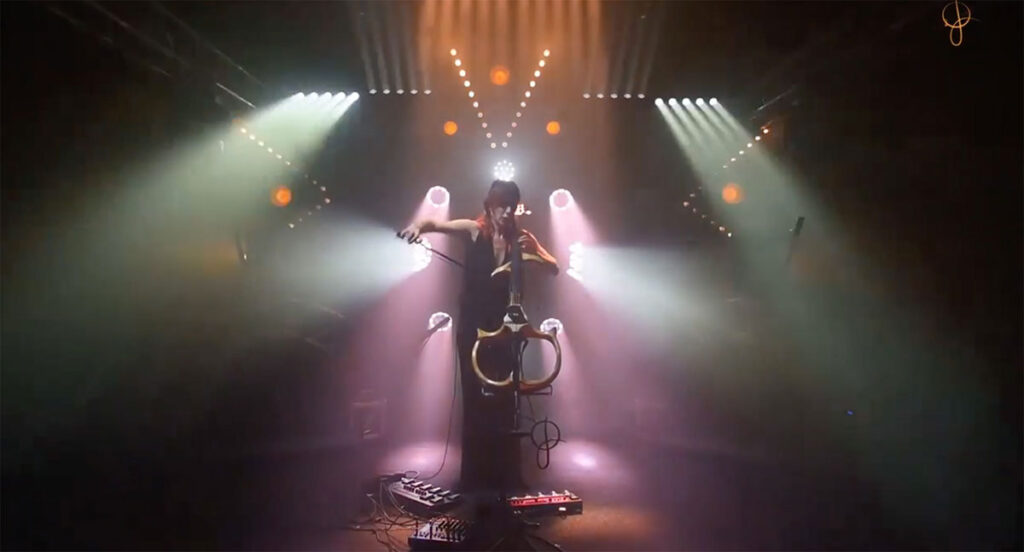Although immensely rewarding, putting light to music is never an easy undertaking. There are some artists, though, whose work unfolds so seamlessly that it opens windows for a lighting design to leap forth and join it in flight. With its naturally fluid rhythms and frictionless interlocking movements, the genre hopping music of cellist and composer Jo Quail clearly falls into this category.
David Howard deeply appreciated the flowing quality of Quail’s music, which combines an eloquent mastery of her instrument with innovative looping techniques, to realize her complex, evocative performance, when he was called upon to light a virtual concert by the London-based artist.
“Jo’s music is truly a joy to bring to life with light,” he said. “The pieces are very strongly connected and rooted to their respective inspiration. This provides a brilliant foundation to draw upon. Using looping and layering techniques, the music itself has a quality and structure that encourage lighting elements to reflect and visualize the sounds Jo produces with her cello. The visual experience builds with the music.”
Featuring six individual compositions taken from a variety of Quail’s discography, the concert took place in an improvised demo space, since the production team did not have access to a livestream studio. Helping Howard create a variety of looks within this space was an extensive collection of CHAUVET Professional fixtures, including the Maverick MK Pyxis, MK2 Wash, MK3 Wash, Rogue R1 FX-B, ÉPIX Strip Tour, and Ovation E-910FC color rendering ellipsoidal.
“We had to achieve a creative solution ourselves within the space available,” said Howard. “From a logistical point of view, we only had a few hours to set up and film all six pieces, each of them about 10 minutes each in length. The entire show was programmed from scratch with a good deal of the show programmed in advance using WYSIWYG. Each piece was a single take and operated live so there really was no room for mistakes. Since Jo’s music is very layered, all the accent lighting that picks up on this music language was structured in the desk in such a way it could be brought seamlessly in and out as she played.
“My familiarity with the CHAUVET Professional fixtures as well as their flexibility were instrumental in helping my design flow with the music,” continued Howard. “We had a variety of Maverick and Rogue fixtures on the rig, so we varied the mix used in each song. This allowed us to create some distinct variations between the different pieces, while still having a consistent and cohesive look throughout out the concert.”

Also adding variety to the lighting design were the rig’s ÉPIX Strip Tour fixtures. The one-meter long RGB linear unit served different functions on different pieces throughout the concert.
“I often use ÉPIX fixtures to create a virtual set on camera,” said Howard. “For this set of concerts, they were used to carry the story of each composition. In the song Gold, we had them represent a beating heart. With White Salt Stag and Reya Pavan they served as a dynamic element that accentuated specific layers of the music.”
The ÉPIX fixtures were positioned so they wouldn’t appear on camera when they weren’t being used. During the performance of South West Night, Howard used individual pixels on the strips to simulate a celestial sky as the sun slowly set with the approach of nightfall. At other points, the ÉPIX fixtures were used to draw eyes back to Quail herself, such as during Mandrel Cantus, a piece inspired by the forgery of metal, when the strips emulated the sparks flying off of the cellist as she played.
Howard also relied on the Maverick MK Pyxis to expand his visual interpretation of his client’s captivating sound. “Jo’s style can at times be very industrial, and the aesthetic of the Pyxis fixture really complements this and works on camera,” he said. “In Mandrel Cantus a beat and a base tone are repeated on different time signatures. The inside beam and outer ring of the fixture pick up these hits separately, which overlap on every forth loop. Having this accentuated on a single fixture positioned in the background on all shots in this multicamera stream brings these sounds to the forefront.”
It was not only light, but also darkness that allowed Howard’s design to weave its way so naturally through the nuances of Quail’s music. “I think darkness and silence go together naturally” he said. “Jo’s musical technique means the pieces are formed of sounds that loop and build out of the silence as a piece is played.”
Powered by this technique, Quail’s simple, yet infinitely complex, music calls for a lighting design that can accompany it on its magical dance. During this 60-minute series of performances, David Howard’s work proved to be an ideal partner.